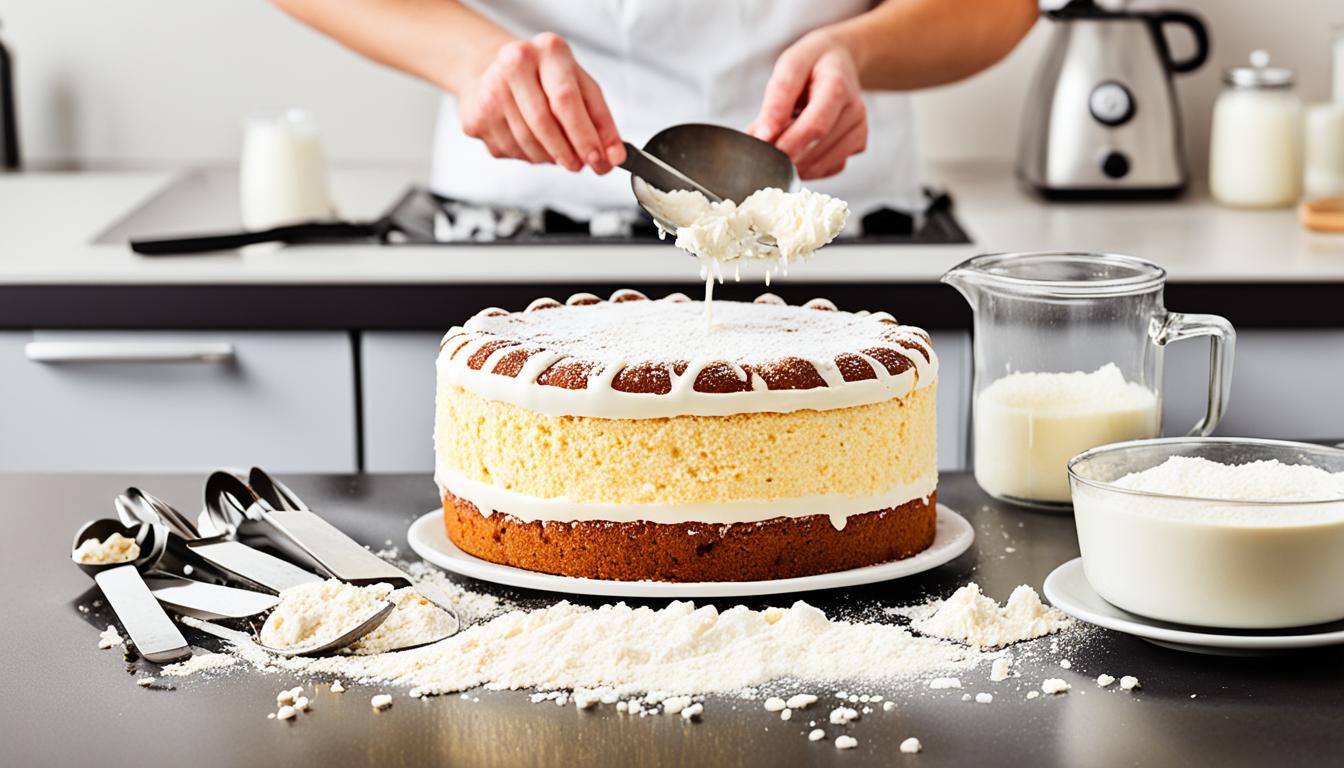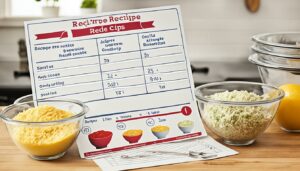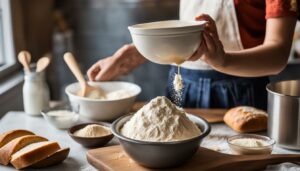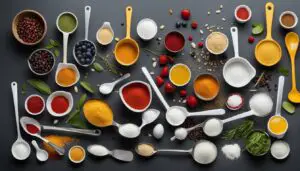Originally posted on March 26, 2024 @ 8:05 pm
Have you ever found yourself wanting to bake a cake but needing to adjust the recipe to make a smaller batch? Perhaps you only have half of the required ingredients, or you simply want to avoid having too many leftovers. But here’s the burning question: can a cake recipe be cut in half without compromising the final result?
Scaling a recipe involves either multiplying or dividing the ingredients to adjust the yield. To scale a recipe up, multiply all ingredients by the scaling amount. For example, doubling a recipe means multiplying each ingredient by two. To scale a recipe down, divide all ingredients by the scaling amount. For example, halving a recipe means dividing each ingredient by two. But is it really that simple? Are there any pitfalls to avoid? Let’s dig deeper and find out!
Contents
- 1 When to Scale a Recipe Up
- 2 When to Scale a Recipe Down
- 3 Tips for Scaling Recipes
- 4 Mini Cakes: A Small Batch Alternative
- 5 Adjusting Pan Sizes for Mini Cakes
- 6 Substitutes for Scaling Down Half a Cake Mix
- 7 Vegan Egg Alternatives for Scaling Down a Cake Mix
- 8 Conclusion
- 9 FAQ
- 9.1 Can a cake recipe be cut in half?
- 9.2 How do you adjust a cake recipe?
- 9.3 When should a recipe be scaled up?
- 9.4 When should a recipe be scaled down?
- 9.5 What are some tips for scaling recipes?
- 9.6 How can mini cakes be made?
- 9.7 What pan size is recommended for mini cakes?
- 9.8 How do you scale down half a cake mix?
- 9.9 What are vegan egg alternatives for scaling down a cake mix?
- 9.10 Can a cake recipe be cut in half without compromising taste or texture?
- 10 Source Links
Key Takeaways:
- Scaling a recipe involves multiplying or dividing the ingredients to adjust the yield.
- Recipe scale calculators can assist in determining the correct measurements.
- Double-check the final measurements after using a calculator, as certain parts of the recipe may not scale automatically.
- Scaling a recipe up is necessary when you need to make more than the original yield.
- Scaling a recipe down is necessary when you want to make less than the original yield.
When to Scale a Recipe Up
Scaling a recipe up is necessary when you need to make more than the original yield. This could be for a larger gathering or when you want to have leftovers for later. To increase the recipe portions, you’ll need to multiply each ingredient by the scaling factor. For example, if a cake recipe yields two 8-inch layers and you want to make three layers, you would multiply the recipe by 1.5.
Using a recipe scale calculator can be incredibly helpful in determining the correct measurements. It’s a simple tool that takes the original recipe and the desired yield, and calculates the adjusted amounts for each ingredient. This takes the guesswork out of scaling up and ensures accurate results.
When scaling up a recipe, it’s important to round up or down to simplify the ingredient amounts. It’s better to have slightly more batter than not enough, as you can always trim any excess once the cake is baked. Plus, having a little extra is handy if you want to make cupcakes or try out a different size pan.
“Scaling up a recipe is a great way to ensure you have enough food for larger gatherings or events. Just don’t forget to adjust the cooking times if needed!”
| Original Recipe | Scaled Up Recipe |
|---|---|
| 2 cups all-purpose flour | 3 cups all-purpose flour |
| 1 tsp baking powder | 1.5 tsp baking powder |
| 1/2 tsp salt | 3/4 tsp salt |
| 1 cup sugar | 1.5 cups sugar |
| 1/2 cup unsalted butter | 3/4 cup unsalted butter |
| 2 large eggs | 3 large eggs |
| 1 tsp vanilla extract | 1.5 tsp vanilla extract |
| 1 cup milk | 1.5 cups milk |
Remember, recipe portion control not only ensures you have enough food but also maintains the balance of flavors. Scaling up a recipe too much could result in an overpowering taste, so it’s important to find the right balance.
When to Round Up or Down the Measurements
When scaling up a recipe, it’s important to round up or down the ingredient measurements to simplify the amounts. Here are a few tips on when to round up or down:
- If the original recipe calls for 1 1/2 cups of flour and you scale it up by 1.5, rounding down to 2 cups would be sufficient.
- For liquid ingredients, it’s generally safe to round up or down to the nearest 1/4 cup or 50 mL.
- For smaller measurements like spices, round up or down to the nearest 1/4 or 1/8 teaspoon depending on your preference.
Keep in mind that these are general guidelines and it’s always best to use your judgement and taste as you go. Recipe scale calculators can give you precise measurements, but it’s important to adjust them based on your individual taste preferences.
When to Scale a Recipe Down
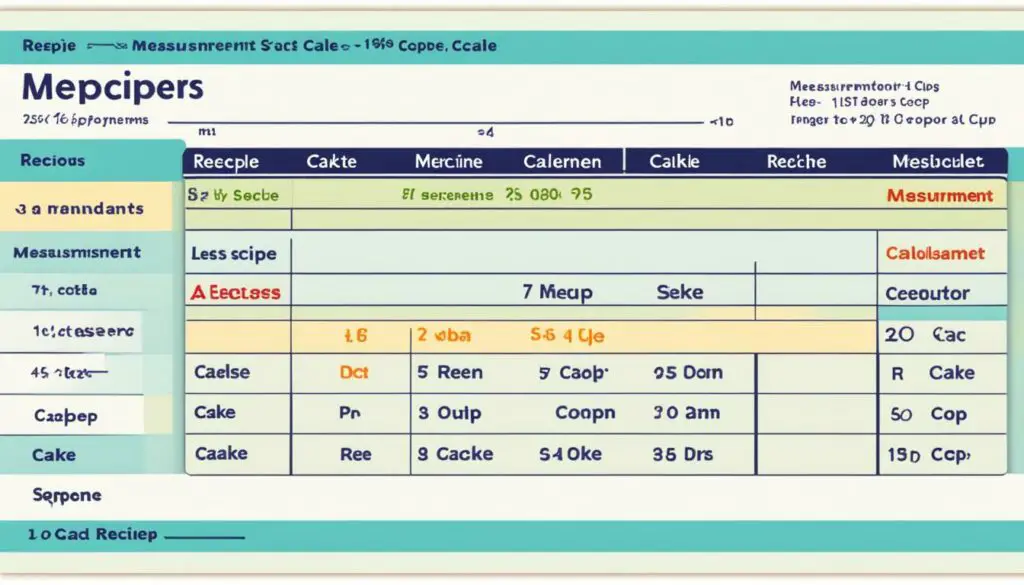
Scaling a recipe down is a common practice when you want to make a smaller portion than the original yield. Whether you’re cooking for a smaller group or simply don’t want leftovers, reducing recipe proportions can be easily achieved.
When scaling a recipe down, the key is to divide each ingredient by the scaling amount. For example, if a recipe yields 24 cupcakes but you only want 6, you would divide each ingredient by 4 or 0.25. This ensures that the proportions are adjusted accordingly for the desired quantity.
To make this process even simpler, you can use a recipe scale calculator. These handy tools allow you to input the original recipe measurements and the desired scaled-down yield. The calculator will then automatically calculate the adjusted measurements for each ingredient.
It’s important to round up or down the ingredient amounts for simplicity and accuracy. Additionally, consider the specific ingredients and their characteristics when scaling down a recipe. Certain ingredients may require slight modifications or substitutions to maintain the desired taste and texture.
“Scaling a recipe down allows you to enjoy your favorite dishes without the need for large quantities. By dividing each ingredient in proportion, you can achieve the perfect serving size with ease.”
Benefits of Scaling Down Recipes
There are several advantages to scaling down recipes:
- Portion Control: Scaling down recipes helps in maintaining portion control, especially when following dietary restrictions or trying to manage calorie intake.
- Reduced Waste: By making smaller portions, you can minimize food waste and avoid leftovers that often go uneaten.
| Original Recipe | Scaled-Down Recipe |
|---|---|
| 24 cupcakes | 6 cupcakes |
| 2 cups all-purpose flour | 1/2 cup all-purpose flour |
| 1 cup sugar | 1/4 cup sugar |
| 1/2 cup butter | 2 tablespoons butter |
| 1 teaspoon vanilla extract | 1/4 teaspoon vanilla extract |
| 1/2 teaspoon baking powder | 1/8 teaspoon baking powder |
| 1/4 teaspoon salt | 1/16 teaspoon salt |
As shown in the table above, scaling down a cupcake recipe from 24 to 6 reduces the ingredient amounts accordingly to achieve the desired yield. Recipe scale calculators make it even easier to obtain precise measurements for a successful scaled-down recipe.
Tips for Scaling Recipes
Scaling a recipe can be challenging if you’re unsure where to start. But don’t worry, we’ve got you covered with some handy tips to make the process a breeze.
1. Use the Scaling Equation
To determine the scaling amount for your recipe, use the following equation:
(Anticipated Recipe Yield) / (Current Recipe Yield) = Scaling Amount
For example, if a recipe yields 12 cookies but you want to make 24, the scaling amount would be 24/12 = 2. This means you would need to double each ingredient.
2. Leverage Recipe Scale Calculators
If you prefer a more precise approach, recipe scale calculators can be a great asset. These handy tools help you adjust ingredient quantities based on your desired yield. Simply input the original recipe details and the desired serving size, and the calculator will do the math for you.
3. Consider Recipe Type and Ingredients
When scaling a recipe, it’s important to consider the specific recipe type and ingredients involved. Some recipes may require adjustments or substitutions to maintain the desired taste and texture. For example, delicate recipes like soufflés may not scale well due to their highly sensitive nature.
4. Stay Organized with Measurements
Keep your cooking measurements on point by using precise tools like measuring cups and spoons. Accurate measurements are crucial, especially when scaling recipes, as even small variations can significantly impact the final result.
5. Experiment and Adapt
Don’t be afraid to get creative in the kitchen! Scaling recipes opens up a world of possibilities for experimentation. Feel free to adapt flavors, adjust cooking times, or switch up ingredients to suit your taste preferences.
6. Practice Makes Perfect
Scaling recipes may take a bit of practice, but with time and experience, you’ll become a pro at adjusting quantities and achieving the perfect outcome. Don’t be discouraged if your first attempt isn’t perfect. Keep trying, learning, and exploring to master the art of scaling recipes.
With these kitchen tips and the help of a recipe scale calculator, you’ll be able to confidently adjust any cake recipe to meet your needs. So go ahead and start experimenting with different serving sizes and enjoy the delicious results!
Mini Cakes: A Small Batch Alternative
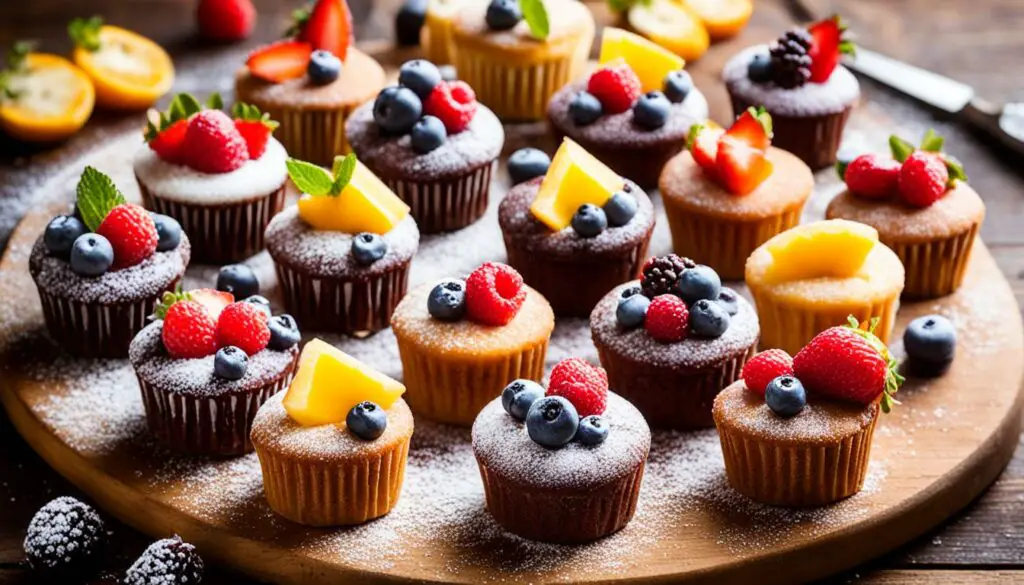
Mini cakes offer a delightful and manageable alternative to full-sized cakes, making them perfect for intimate gatherings or when you want individual portions. Serving 2-4 people in a single sitting, these mini treats eliminate the need for leftovers, ensuring freshness with every bite.
To create mini cakes, you can simply use your favorite full-sized cake recipe and modify it to suit your needs. The key is to divide the batter into smaller 6-inch round pans instead of the usual larger cake pans. This modification allows for individual servings, opening up a world of creative possibilities.
While the proportions may vary slightly due to the smaller size of the pans, resulting in slightly shorter or taller cakes compared to the original recipe, the baking time remains relatively unchanged. It’s always a good idea to keep a close eye on the cakes while they are in the oven to ensure they are baked to perfection.
Mini cakes provide a fantastic opportunity to experiment with different flavors and frostings. Instead of making one large cake with a single flavor, you can create a variety of mini cakes with different flavors and toppings. From classic combinations like chocolate and vanilla to more adventurous options like lemon raspberry or cookies and cream, the possibilities are endless.
Each mini cake becomes an individualized masterpiece, allowing you to cater to everyone’s preferences. You can even personalize them further by adding decorative touches such as sprinkles, edible flowers, or a drizzle of chocolate sauce. These mini cakes are not only visually appealing but also create a memorable and enjoyable experience for everyone.
Whether you are hosting a small gathering, celebrating a special occasion, or simply want to enjoy a delicious treat without the excess, mini cakes offer the perfect solution. So go ahead, grab your favorite cake recipe, modify it for mini cakes, and let your creativity soar!
Adjusting Pan Sizes for Mini Cakes
When making mini cakes, it’s important to choose the right pan size. 6-inch round pans with a depth of at least 2 inches are recommended. A standard cake mix that yields two 8-inch round layers can typically be divided to make two 6-inch cakes. Similarly, a recipe calling for an 8-inch square or 9-inch x 13-inch pan can be divided to make two 6-inch cakes. The capacity of four 6-inch pans is similar to a 9-inch x 13-inch pan, resulting in similar cake heights. Baking times may need slight adjustments but generally remain within the original timeframe.
Key Points:
- Use 6-inch round pans with a depth of at least 2 inches for mini cakes.
- Divide a standard cake mix for two 8-inch round layers to make two 6-inch cakes.
- Divide recipes calling for an 8-inch square or 9-inch x 13-inch pan to make two 6-inch cakes.
- Four 6-inch pans have a similar capacity to a 9-inch x 13-inch pan, resulting in similar cake heights.
- Baking times may need slight adjustments but generally remain within the original timeframe.
Substitutes for Scaling Down Half a Cake Mix
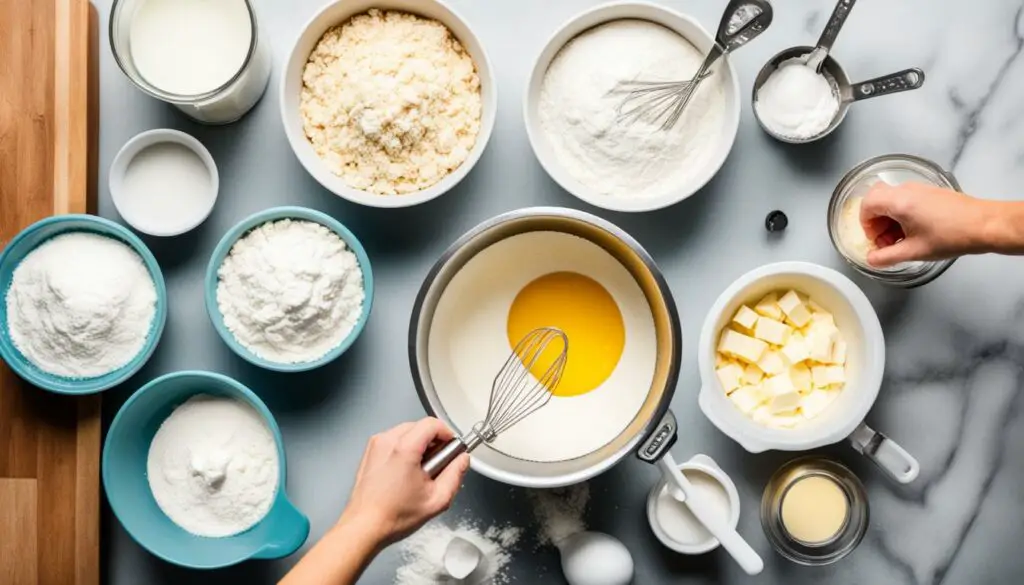
For those who prefer using boxed cake mixes, there are options for scaling down half a mix. Dividing the mix into equal portions can be achieved by weighing on a scale or measuring with cups. The water and oil called for in the mix can be halved accordingly. When it comes to eggs, using one whole egg plus half a beaten egg is a common solution. Alternatively, substitutions like unsweetened applesauce or yogurt can work, but results may vary in terms of taste and texture.
If you’re looking to reduce the size of a boxed cake mix to make a smaller cake or fewer cupcakes, it’s possible to achieve the desired proportions with a few simple adjustments. Here’s a helpful guide on substituting ingredients to scale down a cake mix:
- Weigh or measure the cake mix: Start by dividing the total weight or quantity of the cake mix into halves. If you don’t have a kitchen scale, you can use measuring cups to estimate an equal division.
- Halve the liquids: The boxed cake mix typically requires the addition of water and oil. To scale down, halve the recommended amount of water and oil specified on the packaging.
- Adjust the eggs: The number of eggs required may vary depending on the specific cake mix. To achieve the right proportions, use one whole egg and add half of a beaten egg. This can be achieved by lightly beating an egg and using half of it in the cake mix.
- Consider alternatives: If you prefer to avoid using eggs or are looking for vegan options, you can substitute them with unsweetened applesauce, mashed banana, or plain yogurt. These alternatives can add moisture and help bind the ingredients together.
It’s important to note that while ingredient substitutions can work, they may affect the final taste and texture of the cake. Experimenting with different substitutions can help you find the right balance for your desired outcome.
Example:
Here’s an example of how you can scale down a boxed cake mix:
| Full Boxed Cake Mix Recipe | Half Boxed Cake Mix Recipe |
|---|---|
| 1 box of cake mix | 1/2 box of cake mix |
| 1 cup of water | 1/2 cup of water |
| 1/2 cup of oil | 1/4 cup of oil |
| 3 eggs | 1 whole egg + 1/2 beaten egg |
“Scaling down a boxed cake mix allows you to enjoy a smaller portion of your favorite flavors without the worry of leftovers. Experimenting with ingredient substitutions can lead to unique and delicious results. Just be sure to adjust the proportions carefully to maintain the desired taste and texture.” – Cake Enthusiast
Vegan Egg Alternatives for Scaling Down a Cake Mix
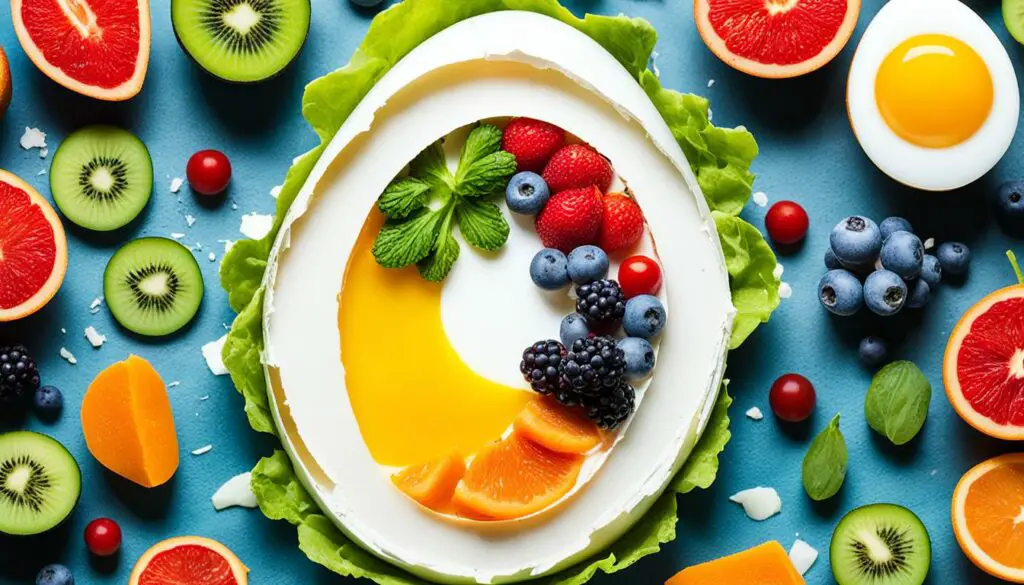
For those following a vegan diet, there are several egg alternatives that can be used to scale down a cake mix recipe. These substitutes provide a great way to enjoy delicious cakes while adhering to a plant-based lifestyle. Here are some popular vegan egg alternatives:
- Bob’s Red Mill Egg Replacer: This versatile egg replacer can be used to substitute for whole eggs, egg whites, or egg yolks in a cake recipe. It’s made from a combination of potato starch, tapioca flour, baking soda, and psyllium husk.
- Unsweetened Applesauce: Another excellent vegan substitute for eggs is unsweetened applesauce. It adds moisture to the cake and helps bind the ingredients together. Use 1/4 cup of applesauce for each egg in the original recipe.
- Plain Yogurt: Plain vegan yogurt can also be used as an egg substitute. It works well in recipes that require a moist and tender texture. Use 1/4 cup of yogurt for each egg in the original recipe.
When using egg replacers, it’s important to follow the instructions on the packaging. In most cases, the replacers need to be combined with water and allowed to thicken before adding them to the cake mix. This step helps replicate the binding and leavening properties of eggs.
Experiment with different vegan egg substitutes to find the best results in terms of flavor and texture. Each substitute may provide a slightly different outcome, so don’t be afraid to get creative and try different combinations.
Baking Tips for Using Vegan Egg Substitutes
Here are some additional tips to keep in mind when using vegan egg substitutes in your scaled-down cake mix:
- Ensure proper leavening: Since vegan egg substitutes may not have the same leavening properties as eggs, consider adding a bit more baking powder or baking soda to ensure proper rise and texture.
- Adjust liquid ingredients: Depending on the substitute used, you may need to adjust the amount of liquid in the recipe. If the batter appears too dry, add a small amount of additional liquid, such as plant-based milk, to achieve the desired consistency.
- Monitor baking time: Vegan cakes may require slightly longer baking times than traditional cakes. Keep a close eye on the cake as it bakes and use a toothpick or cake tester to check for doneness.
By incorporating these baking tips and choosing the right vegan egg substitute, you can successfully scale down a cake mix recipe without compromising flavor or texture. Enjoy your vegan creation!
Conclusion
Scaling a cake recipe to achieve the desired yield is possible through careful modification of ingredients. Utilizing recipe scale calculators can aid in determining the correct measurements, but it is essential to verify the final amounts and consider any specific ingredient adjustments that may be necessary. For those looking to create smaller batches, mini cakes provide an excellent alternative, allowing for experimentation with a variety of flavors and frostings. Even when using boxed cake mixes, dividing the mix and adjusting other ingredients can be done to create a smaller portion without compromising taste or texture. Additionally, individuals following a vegan diet can find alternatives for eggs to suit their dietary restrictions.
By employing the right techniques and adjustments, it is entirely feasible to halve a cake recipe successfully. Whether you are looking to prepare a smaller portion or experiment with new flavors, recipe modification can help you achieve your desired outcome without sacrificing the deliciousness of your favorite cake recipes.
So go ahead and confidently adjust your cake recipes to suit your needs, whether it’s by halving the recipe or exploring alternative options. With a little practice and a touch of creativity, you can enjoy the perfect-sized cake that satisfies your cravings and delights your taste buds.
FAQ
Can a cake recipe be cut in half?
Yes, a cake recipe can be cut in half by dividing all the ingredients by two to adjust the yield.
How do you adjust a cake recipe?
To adjust a cake recipe, multiply or divide the ingredients to scale the yield up or down. Use a recipe scale calculator to determine the correct measurements.
When should a recipe be scaled up?
A recipe should be scaled up when you need more than the original yield. Multiply each ingredient by the scaling amount, for example, doubling the recipe.
When should a recipe be scaled down?
A recipe should be scaled down when you want to make less than the original yield. Divide each ingredient by the scaling amount, for example, halving the recipe.
What are some tips for scaling recipes?
Some tips for scaling recipes include rounding up or down to simplify ingredient amounts, double-checking the final measurements, and considering ingredient adjustments or substitutions.
How can mini cakes be made?
Mini cakes can be made by using a full-sized cake recipe and dividing the batter into smaller 6-inch round pans. The proportions may vary slightly, but the baking time remains similar.
What pan size is recommended for mini cakes?
6-inch round pans with a depth of at least 2 inches are recommended for making mini cakes. A standard cake mix for two 8-inch round layers can typically be divided to make two 6-inch cakes.
How do you scale down half a cake mix?
To scale down half a cake mix, divide the mix into equal portions using a scale or measuring cups. Halve the water and oil called for in the mix and consider options like using one whole egg plus half a beaten egg as a common solution for eggs.
What are vegan egg alternatives for scaling down a cake mix?
Vegan egg alternatives for scaling down a cake mix include products like Bob’s Red Mill Egg Replacer, unsweetened applesauce, or plain Greek yogurt. Experimentation is important to find the best results in terms of flavor and texture.
Can a cake recipe be cut in half without compromising taste or texture?
Yes, with the right techniques and adjustments, a cake recipe can be cut in half without compromising taste or texture. Proper scaling, ingredient modifications, and accurate measurements are key to achieving successful results.

